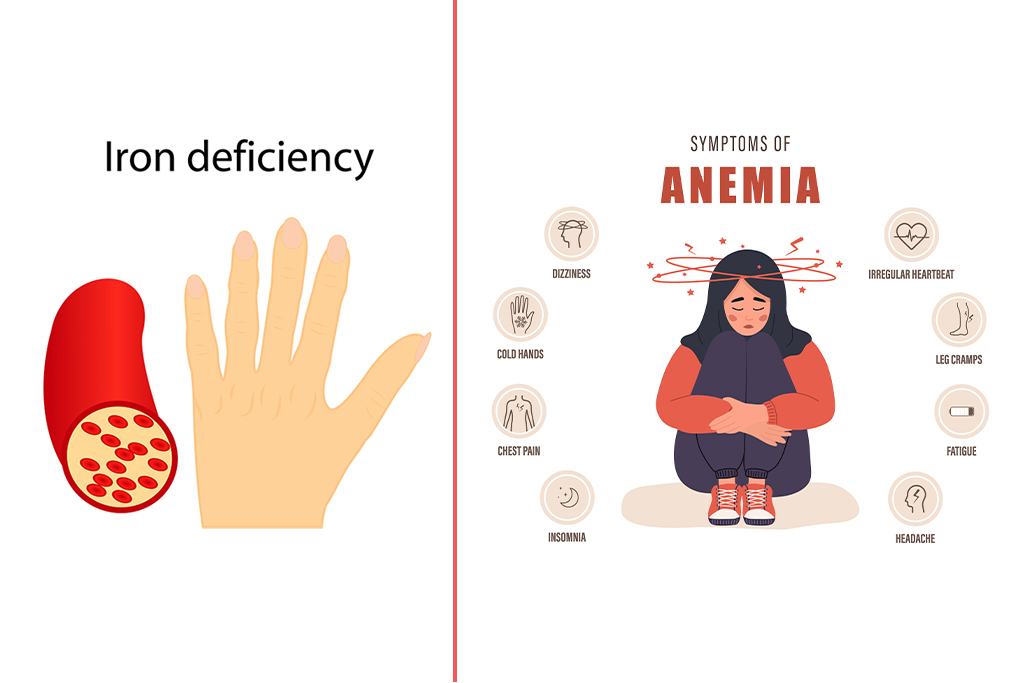 Join Membership
Join Membership
We Are Now Open On Saturdays
50% off all dental treatments and 25% all medical services amazing value for only £20 a month

Feeling dizzy, tired, or breathing shortness on a daily basis are often easily dismissed off as just a sign of busy lifestyle. Yet in many circumstances, these may be symptoms of something more serious –in most cases they commonly point to anaemia or iron deficiency. Although the two terms are often used interchangeably, conventionally they are not the same thing. It is important to know the difference between the two, as it can impact how it is diagnosed and treated.
Both anaemia and iron deficiency are relatively common in the UK, especially amongst females, teenagers, older adults, and vegetarians. According to the NHS, iron deficiency is the most common nutritional deficiency in the world, and anaemia can impact as many as 1 in every 10 women in their reproductive years. While it is common, symptoms often develop gradually which makes anaemia or iron deficiency easy to miss until fatigue creeps in.
In this blog, we will explain how iron deficiency and anaemia differ, the early warning signs of both, how to diagnose them, and what their potential treatment options can be.
Iron is a vital mineral required for the synthesis of haemoglobin – the protein present in red blood cells that transport oxygen around the body. If you don’t have sufficient iron, your body cannot produce enough haemoglobin. As a consequence, some of your organs and tissues won’t receive enough oxygen, leading you to feel weak and tired.
Iron deficiency means that your body has low iron stores – assessed with ferritin and some other markers. In the early stages of iron deficiency, the red blood cell count can still be normal. This stage can be called iron deficiency without anaemia. If the iron deficiency is not treated, it can progress to iron deficiency anaemia (IDA). During IDA, the red blood cells are smaller and paler than usual due to insufficient haemoglobin being produced in the red blood cells.
Several lifestyle and medical factors can lead to lower levels of iron:
NHS guidance recommends investigating the cause of iron deficiency in all adult men and post-menopausal women (and anyone with red-flag features), not just those over 50, as GI blood loss must be excluded.
Anaemia is an umbrella term – it refers to having a lower number of red blood cells or less haemoglobin than normal, which reduces the blood’s capacity to carry oxygen. There are many forms of anaemia, and the most common type in the UK is iron deficiency anaemia, but it is not the only type.
While it is true that iron deficiency can result in anaemia, it is not valid to assume that iron deficiency is the only cause of anaemia. This distinction is essential, since treatment depends on the underlying cause of the blood abnormality.
|
Feature |
Iron Deficiency |
Anaemia |
|
Definition |
Low iron stores in the body |
Low red blood cells or low haemoglobin |
|
Main Cause |
Lack of iron intake, absorption or loss |
May be due to iron or other vitamin deficiencies, or from a chronic disease or problems with the bone marrow, etc. |
|
Stage of Disease |
Can occur prior to the development of anaemia |
Indicates that the oxygen-carrying capacity is impaired |
|
Diagnosis |
Low ferritin, low iron, but normal haemoglobin (early stage) |
Low haemoglobin, with or without specific nutrient deficiencies |
|
Treatment Focus |
Restoring iron levels and addressing the underlying cause |
The treatment depends on the identified cause, and may include iron, B12, folate or one of several options |
Overall, iron deficiency is the cause, and anaemia is the effect – but not in all cases.
Signs of iron deficiency and anaemia can appear to be similar, however, the two conditions have some slight differences which may help you distinguish between them.
Symptoms of Anaemia (once the deficiency is more severe)
As the body gradually adapts, many individuals with mild anaemia may not know they have it until their levels of haemoglobin drop to a dramatically lower level. This is why routine screening is important, particularly forhigh-risk groups.
Certain groups are at increased risk of developing iron deficiency or anaemia in the UK:
Acknowledging these risk factors is crucial to determine when to look for early indicators of deficiencies.
In the UK, anaemia and iron deficiency diagnoses are clear and straightforward.
Blood tests usually include:
Additionally, doctors may check thyroid and kidney function, as in certain situations systemic disease may mimic features of anaemia.
If testing confirms iron deficiency, further tests may be warranted to investigate the underlying cause, such as gastrointestinal investigations to check for malabsorption or bleeding.
If you want results more quickly, many private clinics in London provide anaemia blood test in London with same-day results and assessment by a medical professional.
Treatment can vary based on the degree of deficiency and its underlying cause.
If you are anaemic due to vitamin B12 or folate deficiency, you will be prescribed injections or supplements. For anaemia from chronic illness, it is necessary to treat the underlying medical condition and not just supplement the nutrients.
While not every case is preventable, lifestyle and eating habits significantly influence your ability to reduce risk.
Some tips:
Healthy iron levels improve not only your overall energy levels, but also your cognitive and immune function.
You should see your GP or another healthcare professional if you experience:
Iron deficiency anaemia can put strain on your heart, lead to complications in pregnancy, and reduced immunity if not treated.Getting checked with a blood test is easy to assess if you have low iron, and improving your deficiency can result in a quick recovery.
When you review your blood test results, you may see the following:
|
Test |
Normal Range (approx.) |
What Low Means |
|
Haemoglobin (Hb) |
120–160 g/L (female) 130–180 g/L (male) |
Anaemia |
|
Ferritin |
30–300 µg/L (may vary by lab) |
Low stores of iron |
|
Mean Cell Volume (MCV) |
80–100 fL |
Smaller red cells, usually iron deficiency |
|
Transferrin Saturation |
20–50 % |
Low if iron supply is inadequate |
Doctors interpret these results in relation to your medical history to confirm if it is simply a deficiency, or part of something more complicated.
The good news is that most individuals experience a positive response to treatment once the right diagnosis is made. Iron supplements restore energy levels typically within weeks; however, restoring iron to blood stores may take up to several months.
The key to sustained improvement is to identify the initial reason for the deficiency –heavy menstrual bleeding, dietary habits, or gastrointestinal disturbances. Without addressing the underlying cause, the deficiency is likely to return.
Regular monitoring over time with a healthy diet and proper follow up with your clinician can help to maintain stable iron and haemoglobin levels in the long run.
Understanding the difference between iron deficiency and anaemia is useful to ensure you receive appropriate treatment, and avoid unnecessary fatigue or other complications.
If you feel unusual tiredness, shortness of breath, or think that your diet may not have adequate iron, a simple blood test would be worthwhile.
Our private clinicians at South Kensington MD provide same-day blood tests and discussion of results, along with a professional plan to safely and effectively restore healthy iron levels.
Feeling tired or low on energy? A simple anaemia blood test in London can reveal if low iron is the cause.

